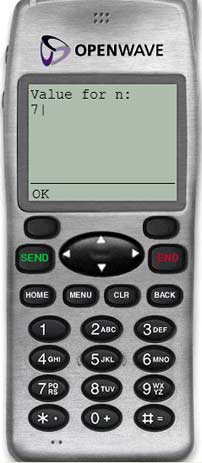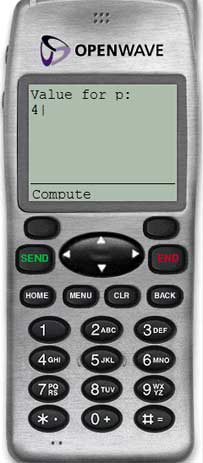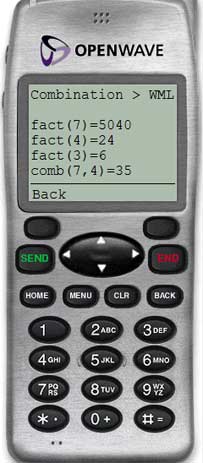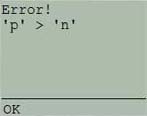  
 Purpose Purpose
This is the WAP version of our combination
application. It uses WML and WMLScript.
Your phone speaks WAP? Great! Point
it at mobile.eric-poncet.com/phone/samples/combination.wml.
 Requirements Requirements
You need a phone emulator that is WMLScript-compliant, such as OpenWave
(see tools section).
 Source
code Source
code
Below is the .wml
file, which is the GUI of our application.
<?xml version="1.0"?>
<!DOCTYPE wml PUBLIC "-//WAPFORUM//DTD WML 1.1//EN" "http://www.wapforum.org/DTD/wml_1.1.xml">
<!--
Combination.wml
Cell phone
WML/WMLScript
-->
<wml>
<card id="input" >
<onevent type="onenterforward">
<refresh>
<setvar name="n" value=""/>
<setvar name="p" value=""/>
<setvar name="n_p" value=""/>
<setvar name="factorialN" value=""/>
<setvar name="factorialP" value=""/>
<setvar name="factorialN_P" value=""/>
<setvar name="combinationNP" value=""/>
</refresh>
</onevent>
<p>
<do type="accept" label="Compute">
<go href="combination.wmls#go()"/>
</do>
Value for n:
<input type="text" name="n" format="*N"/>
Value for p:
<input type="text" name="p" format="*N"/>
</p>
</card>
<card id="result">
<p>
<do type="accept" label="Back">
<go href="#input">
<setvar name="n" value=""/>
<setvar name="p" value=""/>
</go>
</do>
Combination > WML<br/>
<br/>
fact($n)=$factorialN
fact($p)=$factorialP
fact($n_p)=$factorialN_P
comb($n,$p)=$combinationNP
</p>
</card>
</wml>
And here's the .wmls
file, which contains the logic of our app.
//Combination.wmls
//Cell phone
//WML/WMLScript
extern function go()
{
var strN = WMLBrowser.getVar("n"),
strP = WMLBrowser.getVar("p");
var n = Lang.parseInt(strN),
p = Lang.parseInt(strP),
result;
if (n > 0)
if (p > 0)
if (n >= p)
{
WMLBrowser.setVar("n_p", n-p);
WMLBrowser.setVar("factorialN", factorial(n));
WMLBrowser.setVar("factorialP", factorial(p));
WMLBrowser.setVar("factorialN_P", factorial(n-p));
WMLBrowser.setVar("combinationNP", combination(n, p));
WMLBrowser.go("combination.wml#result");
}
else error("'p' > 'n'");
else error("Invalid value for 'p'");
else error("Invalid value for 'n'");
}
function factorial(n)
{
return (n <= 1) ? 1 : n*factorial(n-1); // he-he... let's mix a ternary operator (?) and recursion...
}
function combination(n, p)
{
return factorial(n) div (factorial(n - p) * factorial(p));
}
function error(msg)
{
Dialogs.alert("Error!\n" + msg);
WMLBrowser.setVar("n", "");
WMLBrowser.setVar("p", "");
WMLBrowser.go("#input");
}
 Comments Comments
The .wml
deck contains two cards:
- input is a form allowing the user to input values for
'n' and 'p' and launch the computation
- result displays the results
The .wmls
contains the logic of our applications, that is, the computation
of factorial and combination.
Also, we included a consitency check within the logic,
by making sure that both n and p are not null or zero, and that
n is greater than or equal to p. Here's what the user gets if s/he
enters numbers that do not comply with those rules:

The core functions are located in the .wmls
file: factorial(), combination()
and go(). Only go()
can be called from WML, as it's the only extern
function.
  
Next sample 
|




